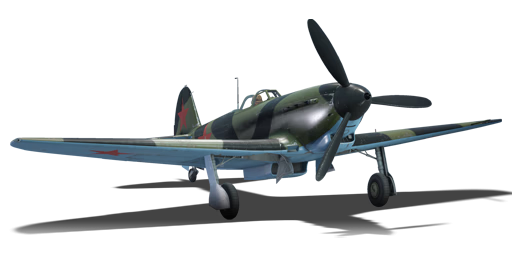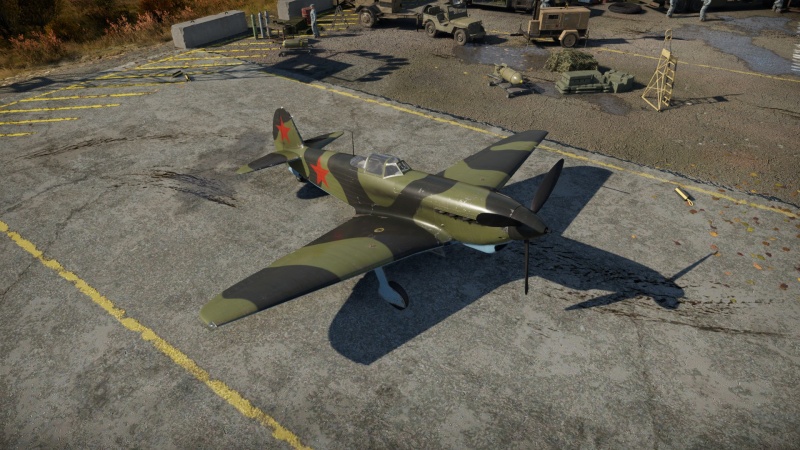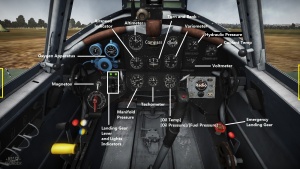Yak-9T
| This page is about the Soviet fighter Yak-9T. For the French version, see Challe's Yak-9T (France). For other versions, see Yak-9 (Family). |
Contents
Description
The Yakovlev Yak-9T was the second variant of the Yak-9 fighter aircraft family. Instead of the usual 20 mm ShVAK cannon, it was armed with a 37 mm Nudelman-Suranov NS-37 cannon with 30 rounds. To compensate for the heavier nose, the cockpit was shifted backwards by 0.4 m. Poor quality control resulted in many oil and coolant leaks from the cannon recoil during test firing, which were solved during the prototype testing stage. Recoil and limited ammunition availability necessitated precise aiming with two- or three-round bursts. The Yak-9T was widely used against enemy ships on the Black Sea and tanks on various fronts (the cannon could penetrate up to 40 mm armour from 500 m), but it was also effective against enemy aircraft (a single cannon hit was usually enough to tear apart the aircraft airframe). Yak-9T had a significant morale impact on the opponent. It was extremely popular among flight crews, owing to its formidable weaponry and excellent flight performance. The aircraft was mass-manufactured from March 1943 to June 1945, and a total of 2,748 aircraft were produced. Flight experiments were carried out on the Central Front in August 1943 by the 16VA ("Vozdushnaya Armia" - Air Army).
Introduced in the Open Beta Test prior to Update 1.27, the Yak-9T is an anti-tank variant with a 37 mm Nudelman-Suranov NS-37 gun capable of firing armour-piercing ammunition that can readily penetrate tank roof armour while diving. Since the ammo capacity is limited to 30 rounds due to the increased weight of the weapon, precise aiming is essential. It is advisable to fire only in short bursts, as continuous firing reduces accuracy and quickly overheats the cannon barrel. This, paired with the Yak-9 fighter aircraft family's superb low-altitude performance, will undoubtedly make the Yak-9T an excellent close-air support plane in the hands of an experienced player.
General info
Dimensions and weight↓
Length: 8.66 meters
Wingspan: 9.74 metres
Height: 3.00 m
Wing area: 17.20 sq.m
Empty weight: 2550 kg
Plug-in volume: No plug-in capability
Maximum practical weight: 2870 kg
Theoretical wing load: 148.26~166.86 kg/m²
Crew members: 1 person
Power configuration
Number of engines: 1 unit
Engine country of origin: Soviet Union
Engine brand: Klimov
Engine type: 12-cylinder twin tandem (V12) liquid-cooled piston engine
Engine model: VK-105PF
Pressurization configuration: two-stage pressurization
Engine weight: 600 kg
Idle power: 4 hp
Sea level static power: 1155 hp (402.44~452.94 hp/ton)
Sea level afterburner power: no afterburner function
Static power of two kilometers: 1191 horsepower (414.98~467.06 horsepower/ton)
5,000 meters static power: 1007 horsepower (350.87~394.90 horsepower/ton)
8 km static power: 664 horsepower (231.36~260.39 horsepower/ton)
Optimum altitude for all levels of supercharger: 700 to 2900 m
Peak static power of supercharger at all levels: 1260 1175 horsepower (439.02~494.12 horsepower/ton 409.41~460.78 horsepower/ton)
Take-off and landing performance and ground maneuverability
Take-off and run distance: 390 meters
Landing run distance: 290 meters
Speed of damage to the landing gear: 320 km / h
Minimum take-off speed: 174 km / h
Landing gear layout: the last three points
Landing Gear Type: Full wheels
Glide turning radius: 5.81 m
Parking elevation angle: 11.3 degrees
Endurance
Distribution of fuel tanks: 1 on each side of the wing (behind the landing gear compartment) and 1 under the pilot's seat
Internal oil volume: 96~320 kg
Maximum static fuel consumption: 5.04 kg/min
Battery life: 19 minutes 02 seconds ~ 63 minutes 28 seconds
Theoretical range: 1092 km
Combat radius: 215 km
Structural strength
Critical speed of disintegration: 682 km/h
Aileron rudder criticality: 380 km/h
Elevator lock rudder criticality: 490 km/h
Steering rudder lock rudder criticality: 420 km/h
Flap gear: Off - Landing
Flap damage speed in each gear (excluding closing gear): 280 km/h
Flight performance
Like other Yak fighters, the Yak-9T has excellent low altitude performance but has abysmal high altitude performance due to the lack of turbo or superchargers incorporated with the engine. When it comes to manoeuvring, the Yak-9T has a strong rudder allowing for wingovers, hammerheads or other manoeuvres which utilise a rudder kick. The rudder used in combination with the aircraft turning decreases the turning radius allowing it into a tighter spiral, typically creating an advantage during small dogfights and skirmishes. The turn rate on the Yak 9T is far superior to the majority of aircraft in its BR making it suitable for vertical turn fighting. While the Yak-9T has an average climb rate for fighters at its battle rating, it may struggle to reach bomber altitude, but will still be an easy target for enemy fighters patrolling the upper elevations. Energy retention for the Yak-9T is decent, though caution is necessary around enemy fighters such as the German Fw 190 which has a more significant energy retention advantage.
| Characteristics | Max Speed (km/h at 4,000 m) |
Max altitude (metres) |
Turn time (seconds) |
Rate of climb (metres/second) |
Take-off run (metres) | |||
|---|---|---|---|---|---|---|---|---|
| AB | RB | AB | RB | AB | RB | |||
| Stock | 576 | 560 | 10000 | 18.8 | 19.5 | 13.7 | 13.6 | 366 |
| Upgraded | 610 | 593 | 17.2 | 18.0 | 18.5 | 16.0 | ||
Details
| Features | ||||
|---|---|---|---|---|
| Combat flaps | Take-off flaps | Landing flaps | Air brakes | Arrestor gear |
| X | X | ✓ | X | X |
| Optimal velocities (km/h) | |||
|---|---|---|---|
| Ailerons | Rudder | Elevators | Radiator |
| < 380 | < 420 | < 490 | > 340 |
Survivability and armour
Comparable to other contemporary fighters, the Yak-9T has proper protection due to the placement of armour protection and bulletproof glass. While the armour protection serves mostly to protect the pilot, the way the aircraft systems are situated, the vulnerable areas are decently protected. Since the Yak-9T has excellent pilot protection, it is unlikely that a pilot snipe should occur. Due to strengthened structure and centralizing of the critical components, it is a real possibility for a skilled pilot to clip an enemies plane with a wingtip and remain unscathed, either slicing the enemy's wing or disabling a propeller. Though the Yak-9T does have fuel tanks located in the wings, they are self-sealing; however, that does not preclude them from catching on fire.
- 64 mm Bulletproof glass in cockpit front
- 64 mm Bulletproof glass pilot's headrest
- 8 mm Steel plate in the pilot's seat
Modifications and economy
Armaments
Offensive armament
The Yak-9T is armed with:
- 1 x 37 mm NS-37 cannon, nose-mounted (30 rpg)
- 1 x 12.7 mm Berezin UB machine gun, nose-mounted (200 rpg)
Usage in battles
The Yakovlev 9T or Yak-9T as it is most popularly referred to in-game, being the most popular of the Yak-9 variants, is best played differently depending on the situation the pilot finds themselves in.
To begin, don't set any gun convergence. Since this aircraft only has 2 guns, a 37 mm in the middle of the engine and a 12.7mm Berezin UB to the side of it (though not enough to the side to need convergence). If you set convergence, it will actually tilt the 37mm to one side and throw off your aim.
After this, take off and make sure that you take off and immediately climb. A twenty-degree angle may be too much to handle depending on the upgrades purchased on the aircraft, so a fifteen-degree climb is recommended. With it, the pilot keeps much-needed speed and agility. Altitude advantage over your opponent is always preferred, and most pilots of the rank that the Yak-9T fights do not choose to climb over 2,000 m (6,561 ft). A good altitude to climb to is 3,000 m (9,842 ft). In this way, altitude advantage is achieved. Be advised this will not always be the case and some enemies will climb above you. If this happens, try to make them bleed energy until they are slower than you and turn fight them.
At high altitude, the Yak-9T is best suited to energy fighting, which means using the Yak's good energy retention to zoom at an opponent, shoot at them, and then climb up and turn back to your opponent and give chase. The Yak at mid to low altitude is best suited to turn-fighting against all nations except for the Japanese. If facing the Japanese, use the same energy fight tactics as stated above, as Japanese planes will be unable to give chase due to the low energy retention of their lightweight aircraft. The Yak-9T comes equipped with flaps, it is critical you use them, as performance is greatly increased in a turn-fight with them extended.
The Yak-9T and all Yak's suffer from a constant engine overheat, properly watching this temperature is critical because if let go too long, the engine will die and the Yak falls fast. Keep eyes on temp at all times. The best advice is to keep the throttle at 90% or lower when not in combat. The Yak-9T is best suited to colder maps if on a hot map, gain altitude and cruise at 85-90% throttle.
The Yak-9T is also famed for its ability to crack open tanks with its cannon - in air battles, it can penetrate even heavy tanks from the back. If you are going to attempt this, load Ground Targets belts (if you only have default belts, half the shells aren't armour-piercing and won't be able to penetrate tanks), look for some tanks and start shooting them, though you must shoot from behind with heavy and medium tanks. Try to avoid convoys going down roads, as those usually have AA vehicles and the longer you loiter over then the higher chance of being hit, developing oil and/or water leaks, and having to return to base. Ammo conservation is the name of the game here, as you only have 30 rounds for the cannon. If you want to only fire your machine gun, the key is "1" by default, and for the cannon it's "2". If you are attacking soft targets the machine gun (loaded with Ground Targets ammunition) may be better and less of a waste of ammo, roughly a dozen shots can be enough. Likewise, your machine gun is useless for attacking medium and heavy tanks, so only fire the cannon when you attack those.
In Ground RB, the Yak is also quite feared, being able to penetrate most if not all tanks at its BR, providing you aim for behind. Your small size combined with your relatively high speed makes you difficult to shoot down for AA vehicles, and your pilot does have bulletproof glass around and some armour plating behind the pilot, making pilot snipes unlikely.
Manual Engine Control
| MEC elements | ||||||
|---|---|---|---|---|---|---|
| Mixer | Pitch | Radiator | Supercharger | Turbocharger | ||
| Oil | Water | Type | ||||
| Controllable | Controllable Not auto controlled |
Controllable Not auto controlled |
Controllable Not auto controlled |
Separate | Controllable 2 gears |
Not controllable |
Pros and cons
Pros:
- 37 mm has a reasonably high rate of fire for its calibre
- The 37 mm is powerful, good for disabling or destroying bombers
- The 37 mm is also very good in Ground RB in disabling vehicles
- Berezin UB machine gun is hard-hitting
- Decent manoeuvrability
- Cannon can knock out medium tanks with several hits in the side or rear
- Good energy retention
- Outperforms most contemporary fighters at lower altitudes (under 4,000 m)
Cons:
- Once the 37 mm runs out of ammo you have a single .50 cal machine gun
- 37 mm has high recoil
- 37 mm is fairly inaccurate even in short bursts
- Lousy high-altitude performance
- Not very fast
- Low rip speed
History
| Archive of the in-game description | |
|---|---|
|
The Yak-9 was a Soviet single-engine fighter of the WWII era. It was the first combat aircraft designed by Alexander Yakovlev's construction bureau. The most mass-produced Soviet fighter of the war, it remained in production from October 1942 to December 1948, with a total of 16,769 built. The Yak-9 was a further modification of the Yak-1 and Yak-7. In its core design, it was a redesign of the Yak-7. With few external differences, Yak-9 was at the same time much more advanced internally. This is not unexpected, as almost two years of design and combat experience of the Yak series went into the Yak-9. Also, at the time aluminium was in much greater supply than it had been two years previously at the start of the war. Amongst other things, the use of metal allowed the plane's weight to be significantly reduced, meaning that more fuel could be stored and that the aircraft could be equipped with more powerful armament and more specialized equipment. The Yak-9T variant, for instance, had an incredibly powerful 37 mm NS-37 cannon firing through the propeller hub. Due to the length of the gun barrel, the pilot's seat had to be moved 40 cm aft, and the airframe was strengthened. The variant carried 30 to 32 cannon shells, as well as 200-220 rounds for the synchronized UB machine gun. Salvo weight for the variant was a whopping 3.74 kg (8.24 lbs). The 37 mm gun allowed for fire at increased ranges, up to 1,200 yards against bomber formations, and 500-600 yards against single non-manoeuvring bombers. The Yak-9T was also successful against ground targets. Armour-piercing shells, fired from 500 yards at an angle of 45 degrees, could penetrate 30 mm of armour. In late 1943, the Yak-9T was used in an anti-shipping role in the Black Sea. A total of 2,748 Yak-9s were built between March 1943 and June 1945. | |
Media
- Skins
- Videos
See also
Links to the articles on the War Thunder Wiki that you think will be useful for the reader, for example:
- reference to the series of the aircraft;
- links to approximate analogues of other nations and research trees.
External links
| A.S. Yakovlev Design Bureau (Яковлев Опытное конструкторское бюро) | |
|---|---|
| Fighters | |
| Yak-1 | Yak-1 · Yak-1B |
| Yak-3 | Yak-3 · Eremin's Yak-3(e) · Yak-3 (VK-107) · Yak-3P · Yak-3T · Yak-3U |
| Yak-7 | Yak-7B |
| Yak-9 | Yak-9 · Yak-9B · Yak-9K · Golovachev's Yak-9M · Yak-9P · Yak-9T · Yak-9U · Yak-9UT |
| Twin-engine fighters | I-29 |
| Jet fighters | |
| Yak-15 | Yak-15P · Yak-15 |
| Yak-17 | Yak-17 |
| Yak-23 | Yak-23 |
| Yak-30 | Yak-30D |
| Yak-141 | Yak-141 |
| Strike aircraft | |
| Yak-2 | Yak-2 KABB |
| Yak-38 | Yak-38 · Yak-38M |
| Bombers | Yak-4 |
| Jet bombers | Yak-28B |
| Foreign use | ▄Yak-3 · Challe's ▄Yak-9T · ◔Yak-9P |
| Captured | ▀Yak-1B |
| USSR fighters | |
|---|---|
| I-15 | I-15 WR · I-15 M-22 · I-15 M-25 · I-15bis · Krasnolutsky's I-15bis |
| I-153 M-62 · Zhukovsky's I-153-M62 · I-153P | |
| I-16 | I-16 type 5 · I-16 type 10 · I-16 type 18 · I-16 type 24 · I-16 type 27 · I-16 type 28 · I-180S |
| I-29 | I-29 |
| I-185 | I-185 (M-71) · I-185 (M-82) |
| I-225 | I-225 |
| ITP | ITP (M-1) |
| MiG-3 | MiG-3-15 · MiG-3-15 (BK) · MiG-3-34 |
| LaGG | I-301 · LaGG-3-4 · LaGG-3-8 · LaGG-3-11 · LaGG-3-23 · LaGG-3-34 · LaGG-3-35 · LaGG-3-66 |
| La | La-5 · La-5F · La-5FN · La-7 · Dolgushin's La-7 · La-7B-20 · La-9 · La-11 |
| Yak-1/7 | Yak-1 · Yak-1B · Yak-7B |
| Yak-3 | Yak-3 · Eremin's Yak-3(e) · Yak-3P · Yak-3T · Yak-3U · Yak-3 (VK-107) |
| Yak-9 | Yak-9 · Yak-9B · Golovachev's Yak-9M · Yak-9T · Yak-9K · Yak-9U · Yak-9UT · Yak-9P |
| Other countries | ▂P-40E-1 · ▂P-47D-27 · ▂Hurricane Mk IIB · ▂Fw 190 D-9 · ▂Spitfire Mk IXc |
| P-39 | ▂P-39K-1 · ▂Pokryshkin's P-39N-0 · ▂P-39Q-15 |
| P-63 | ▂P-63A-5 · ▂P-63A-10 · ▂P-63C-5 |






